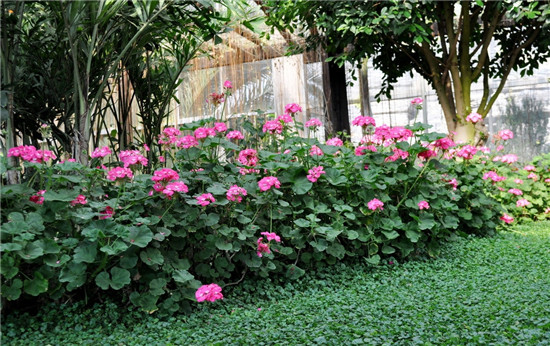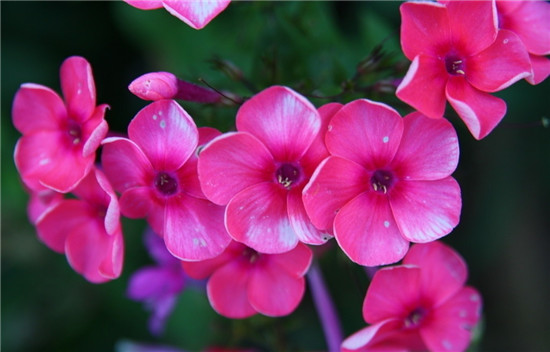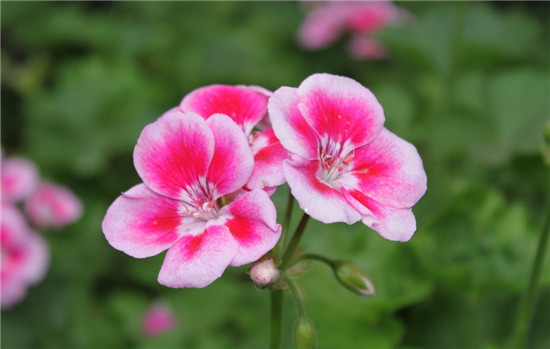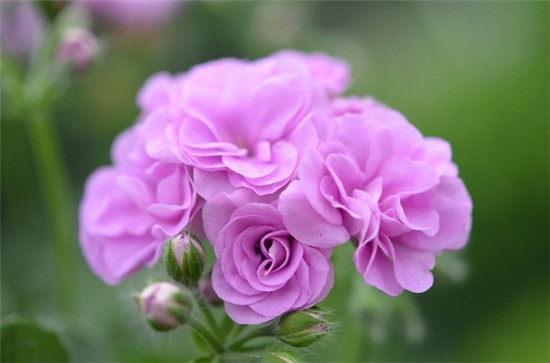How to cultivate geraniums
Geraniums are perennial evergreen herbs or subshrub woody flowers. Let's take a look at the cultivation of geraniums.

Geraniums are native to southern Africa and are now widely cultivated around the world. Young plants are fleshy herbs and old plants are semi-lignified; flowers that decorate windowsills are good in the West, especially in continental Europe, such as Germany, Austria and other countries. Pelargonium commonly known as hydrangea, there are single, semidouble, double and tetraploid varieties.
It can also be divided into upright geranium and hanging geranium stem stout and succulent. Geranium stems erect, fleshy, basally Lignified, distally fleshy, much branched or unbranched, with conspicuous nodes, densely pubescent. Leaves alternate, stipules broadly triangular or ovate, 8-15 mm long, pilose and glandular hairy; petiole 3-10 m long, pilose and glandular hairy; leaf blade rounded or reniform.
Stem heart-shaped, 3-7 cm in diameter, margin undulate and lobed, with rounded teeth, transparent pubescent on both sides, dark red horseshoe-shaped ring within the surface leaf margin.

The geranium likes to be warm in winter and cool in summer. It can blossom normally when the indoor temperature is kept at 10-15 ℃ every day in winter and the temperature at night is above 8 ℃. But the optimum temperature is 15-20 ℃. Geraniums like dryness and hate dampness, and should not be watered too much in winter. See dry and wet. When the soil is wet, the stem is tender, which is not conducive to the sprouting and opening of flower branches; long-term excessive humidity will cause plants to grow too long, flower branches will move up, and the leaves will gradually yellow and fall off.
Geraniums are strong in nature, with few diseases and insect pests; they are also adaptable, and all kinds of soil can grow, but sandy loam soil rich in humus grows best; it likes sunshine, is warm, is slightly resistant to drought, is afraid of stagnant water, and is not resistant to hot summer and hot sun exposure. Plants stop growing in summer, leaves aging, showing a semi-dormant shape, at this time can be transferred to the outdoor ☆ forbidden ☆ shade, stop the application of liquid fertilizer, watering on time, the pot will be put down in rainy days to prevent stagnant water rotting roots.
When the summer passes through the sky in September, you can turn the basin and change the soil, first cut the branches short, leaving only about ten square meters at the base of each branch, so that the new buds can be replaced by new branches. The geranium should be watered moderately, the basin soil should not be too wet, and the basin soil should be semi-dry half a day after watering.

Geraniums are mainly propagated in spring and autumn, but those with greenhouse equipment can also be planted in winter. Generally speaking, spring cuttings can blossom between New year and Spring Festival, while autumn cuttings can blossom at the end of April. The cuttings use new and old branches, but the tender shoots at the end of the branches grow best. Cuttings choose about ten centimeters, retain two to three upper leaves, such as the old strip can also be without leaves, the incision will be slightly shaded dry, inserted in the clean sand. The sand should be kept slightly wet and not flooded. First place in the semi-shade to keep the leaves from wilting, and then gradually come into contact with the sun after three to five days. Generally, it takes root in about two weeks, and it can be put on the pot when the root is three to four meters long.
Sowing and propagation: single seed of pelargonium is easy to bear seeds and can be sowed after harvest. If you want to sow seeds when the weather is cool, dry the seeds and store them in a paper bag. Under the condition of 20 ℃, it can germinate in about 7-10 days. After sub-seedling transplanting, when the seedling grows to 5-7 cm, it is planted in a 10-m flowerpot and can blossom in the following spring.

Cuttage propagation: all plants can be inserted except that the plants are semi-dormant from June to August. But spring and autumn are the best. Cuttings are best taken from the mother plants with consistent flowering, frequent flowering, pure varieties and no diseases and insect pests. The top of the shoot and the tender stem below can be used as cuttings, but the top part is the best, with vigorous growth and fast rooting. After cutting the cuttings, soak them in 100mg / kg indolebutyric acid for 5-10 seconds, then dry them for half a day, let them wilt and insert them into the sand bed or perlite mixed with peat at 1:1. Cover them with a small arched shed and shade when the sun is strong. Keep the temperature 15-20 ℃, take root 2-3 weeks after planting, and transplant when the root length is 3-4 cm.
The above is the whole content of how to cultivate geraniums and how to grow geraniums. I hope this article can help you. Please continue to follow us.
- Prev

What is the flower language of Persia chrysanthemum? the flower meaning of Persia chrysanthemum
What is the flower language of Persia chrysanthemum? the flower meaning of Persia chrysanthemum
- Next

The culture method of tiger tail orchid planting skills of tiger tail orchid
The culture method of tiger tail orchid planting skills of tiger tail orchid
Related
- Wuhan Hospital Iron Tree Blooming Result Was Instantly Frightened by the Gardener Master
- Which variety of camellia is the most fragrant and best? Which one do you like best?
- What is the small blue coat, the breeding methods and matters needing attention of the succulent plant
- Dormancy time and maintenance management of succulent plants during dormancy
- Minas succulent how to raise, Minas succulent plant pictures
- What are the varieties of winter succulent plants
- How to raise succulent plants in twelve rolls? let's take a look at some experience of breeding twelve rolls.
- Attention should be paid to water control for succulent plants during dormant period (winter and summer)
- Watering experience of twelve rolls of succulent plants
- Techniques for fertilizing succulent plants. An article will let you know how to fertilize succulent plants.

